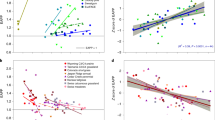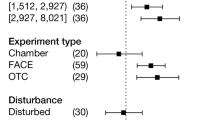Abstract
The concentration of carbon dioxide (CO2) in the Earth's atmosphere is rising rapidly1, with the potential to alter many ecosystem processes. Elevated CO2 often stimulates photosynthesis2, creating the possibility that the terrestrial biosphere will sequester carbon in response to rising atmospheric CO2 concentration, partly offsetting emissions from fossil-fuel combustion, cement manufacture, and deforestation3,4. However, the responses of intact ecosystems to elevated CO2 concentration, particularly the below-ground responses, are not well understood. Here we present an annual budget focusing on below-ground carbon cycling for two grassland ecosystems exposed to elevated CO2 concentrations. Three years of experimental CO2 doubling increased ecosystem carbon uptake, but greatly increased carbon partitioning to rapidly cycling carbon pools below ground. This provides an explanation for the imbalance observed in numerous CO2 experiments, where the carbon increment from increased photosynthesis is greater than the increments in ecosystem carbon stocks. The shift in ecosystem carbon partitioning suggests that elevated CO2 concentration causes a greater increase in carbon cycling than in carbon storage in grasslands.
This is a preview of subscription content, access via your institution
Access options
Subscribe to this journal
Receive 51 print issues and online access
$199.00 per year
only $3.90 per issue
Buy this article
- Purchase on Springer Link
- Instant access to full article PDF
Prices may be subject to local taxes which are calculated during checkout




Similar content being viewed by others
References
Schimel, D.et al. in Climate Change 1995: The Science of Climate Change(eds Houghton, J. T. et al.) 65–131 (Cambridge Univ. Press, (1996)).
Long, S. P. & Drake, B. G. in Topics in Photosynthesis(eds Baker, N. R. & Thomas, H.) 69–107 (Elsevier, Amsterdam, (1992)).
Broecker, W. S., Takahashi, T., Simpson, H. J. & Peng, T. H. Fate of fossil fuel carbon dioxide and the global carbon budget. Science 206, 409–418 (1979).
Gifford, R. M. Carbon dioxide and plant growth under water and light stress, implications for balancing the global carbon budget. Search 10, 316–318 (1979).
Drake, B. G. & Leadley, P. W. Canopy photosynthesis of crops and native plants exposed to long-term elevated CO2: commissioned review. Plant Cell Env. 14, 853–860 (1991).
Canadell, J. G., Pitelka, L. F. & Ingram, J. S. I. The effects of elevated CO2on plant-soil carbon below ground: a synthesis. Plant Soil 187, 391–400 (1996).
Schimel, D. S. Terrestrial ecosystems and the carbon cycle. Global Change Biol. 1, 77–91 (1995).
Harrison, K., Broecker, W. & Bonani, G. Astrategy for estimating the impact of CO2 fertilisation on soil carbon storage. Global Biogeochem. Cycles 7, 69–80 (1993).
Hilbert, D. W., Larigauderie, A. & Reynolds, J. F. The influence of carbon dioxide and daily photon-flux density on optimal leaf nitrogen concentration and root:shoot ratio. Ann. Bot. 68, 365–376 (1991).
Luo, Y., Field, C. B. & Mooney, H. A. Predicting responses of photosynthesis and root fraction to elevated CO2: Interactions among carbon, nitrogen, and growth. Plant Cell Env. 17, 1195–1204 (1994).
Field, C. B., Chapin, F. S. II, Matson, P. A. & Mooney, H. A. Responses of terrestrial ecosystems to the changing atmosphere: A resource-based approach. Annu. Rev. Ecol. Syst. 23, 201–235 (1992).
van Veen, J. A., Liljeroth, E. L., Lekkerkerk, J. A. & van de Geijn, S. C. Carbon fluxes in plant-soil systems at elevated atmospheric CO2 levels. Ecol. Appl. 2, 175–181 (1991).
van de Geijn, S. C. & van Veen, J. A. Implications of increased carbon dioxide levels for carbon input and turnover in soils. Vegetatio 104/105, 283–292 (1993).
Stulen, I. & den Hertog, J. Root growth and functioning under atmospheric CO2 enrichment. Vegetatio 104/105, 99–115 (1993).
Rogers, H. H., Runion, G. B. & Krupa, S. V. Plant responses to atmospheric CO2 enrichment with emphasis on roots and the rhizosphere. Env. Pollut. 83, 155–189 (1994).
Norby, R. J. Issues and perspectives for investigating root responses to elevated atmospheric carbon dioxide. Plant Soil 165, 9–20 (1994).
Hickman, J. C. The Jepson Manual: Higher Plants of California(Univ. California Press, Berkeley, (1993)).
Field, C. B., Chapin, F. S. II, Chiariello, N. R., Holland, E. A. & Mooney, H. A. in Carbon Dioxide and Terrestrial Ecosystems(eds Koch, G. W. & Mooney, H. A.) 121–145 (Academic, Sand Diego, (1996)).
Jackson, R. B., Sala, O. E., Field, C. B. & Mooney, H. A. CO2 alters water use, carbon gain, and yield for the dominant species in a natural grassland. Oecologia 98, 257–262 (1994).
Hungate, B. A., Jackson, R. B., Field, C. B. & Chapin, F. S. II Detecting changes in soil carbon in CO2 enrichment experiments. Plant Soil 187, 135–145 (1996).
Thompson, M. V., Randerson, J. T., Malmström, C. M. & Field, C. B. Change in net primary production and heterotrophic respiration: how much is necessary to sustain the terrestrial sink? Global Biogeochem. Cycles 10, 711–726 (1996).
Luo, Y., Jackson, R. B., Field, C. B. & Mooney, H. A. Elevated CO2 increases belowground respiration in California grasslands. Oecologia 108, 130–137 (1996).
Raich, J. W. & Nadelhoffer, K. J. Belowground carbon allocation in forest ecosystems: global trends. Ecology 70, 1346–1354 (1989).
Higgins, P. A. T. thesis, Stanford Univ. (1996).
Chiariello, N. R. & Field, C. B. in Community, Population and Evolutionary Responses to Elevated Carbon Dioxide Concentration(eds Körner, C. & Bazzaz, F. A.) 139–175 (Academic, San Diego, (1996)).
Drake, B. G.et al. Acclimation of photosynthesis, respiration, and ecosystem carbon flux of wetland on Chesapeake Bay, Maryland, to elevated atmospheric CO2 concentrations. Plant Soil 187, 111–118 (1996).
Parton, W. J., Schimel, D. S., Cole, C. V. & Ojima Analysis of factors controlling soil organic matter levels in Great Plains grasslands. Soil Sci. Soc. Am. J. 51, 1173–1179 (1987).
Oades, J. M. The retention of organic matter in soils. Biogeochemistry 5, 35–70 (1988).
Parton, W. J.et al. Impact of climate change on grassland production and soil carbon worldwide. Global Change Biol. 1, 13–22 (1995).
Ham, J. M., Owensby, C. E., Coyne, P. I. & Bremer, D. J. Fluxes of CO2 and water vapor from a prairie ecosystem exposed to ambient and elevated atmospheric CO2. Agric. For. Meteorol. 77, 73–93 (1995).
Acknowledgements
We thank N. Chiariello, C. Chu, G. Joel, Y. Luo, B. Mortimer, E. Nelson, J.Randerson, H. Reynolds, J. des Rosier, S. Thayer and J. Whitbeck for contributions to the design and execution of the experiment; H. Whitted for help with experimental design and construction; P. Canadell, Z.Cardon, R. Martin and A. Townsend for assistance and advice with the 13CO2 labelling, sampling and interpretation; J. Sulzman for help with the figures; and D. Schimel for help with the isotope calculations. The Jasper Ridge CO2 experiment is supported by grants from the US NSF to the Carnegie Institution of Washington, Stanford University and the University of California, Berkeley. B.A.H. was supported by a National Defense Science and Engineering graduate fellowship and an NSF doctoral dissertation improvement grant. R.B.J. was supported by a grant from NIGEC/DOE and a DOE distinguished postdoctoral fellowship for global change. The National Center for Atmospheric Research is sponsored by the NSF. This is publication number 1344 from the Carnegie Institution of Washington, Department of Plant Biology.
Author information
Authors and Affiliations
Corresponding author
Rights and permissions
About this article
Cite this article
Hungate, B., Holland, E., Jackson, R. et al. The fate of carbon in grasslands under carbon dioxide enrichment. Nature 388, 576–579 (1997). https://doi.org/10.1038/41550
Received:
Accepted:
Issue Date:
DOI: https://doi.org/10.1038/41550
This article is cited by
-
Carbon, nitrogen and phosphorous contents, related enzyme activities and organic matter fractions of litter and soil in a terra firme forest in Central Amazonia
European Journal of Forest Research (2023)
-
Root biomass and cumulative yield increase with mowing height in Festuca pratensis irrespective of Epichloë symbiosis
Scientific Reports (2022)
-
The use of stable carbon isotopes to decipher global change effects on soil organic carbon: present status, limitations, and future prospects
Biogeochemistry (2022)
-
Soil C, N and P cycling enzyme responses to nutrient limitation under elevated CO2
Biogeochemistry (2020)
-
New soil carbon sequestration with nitrogen enrichment: a meta-analysis
Plant and Soil (2020)
Comments
By submitting a comment you agree to abide by our Terms and Community Guidelines. If you find something abusive or that does not comply with our terms or guidelines please flag it as inappropriate.



